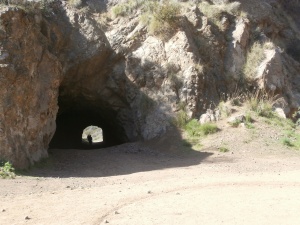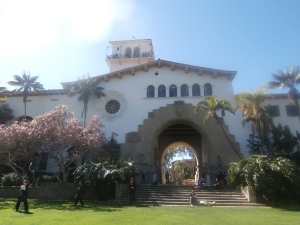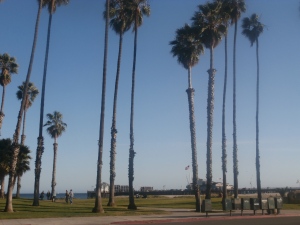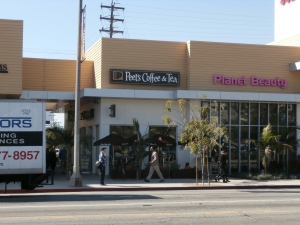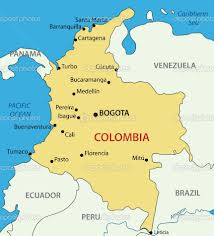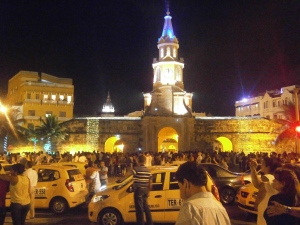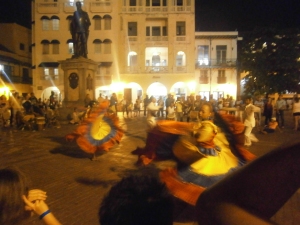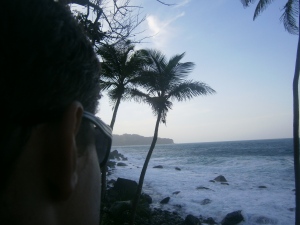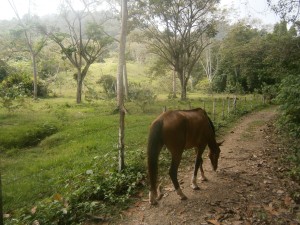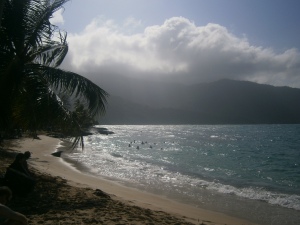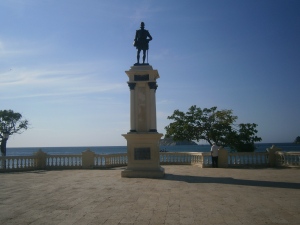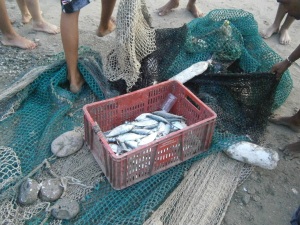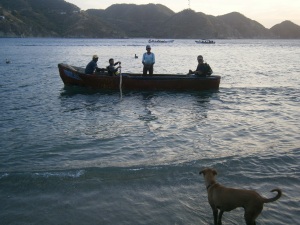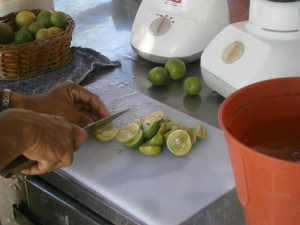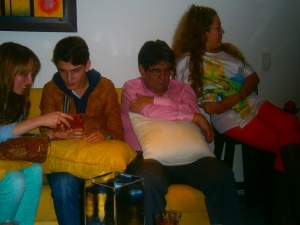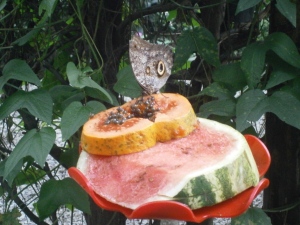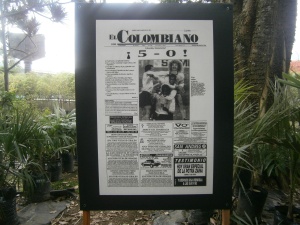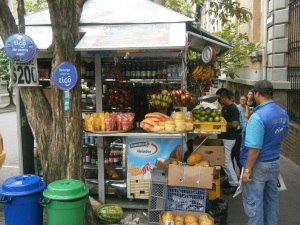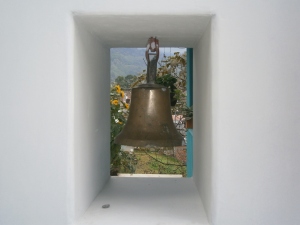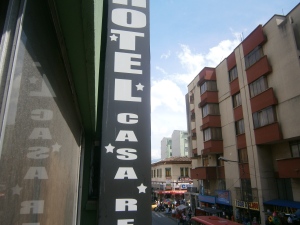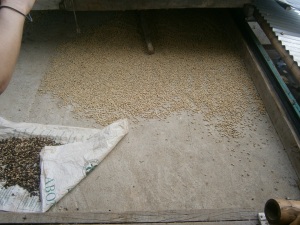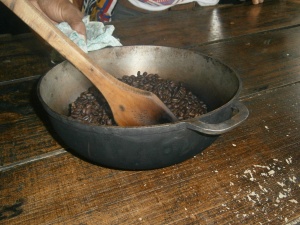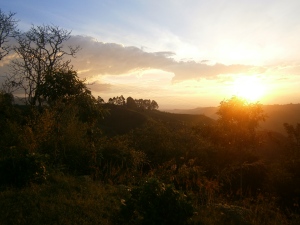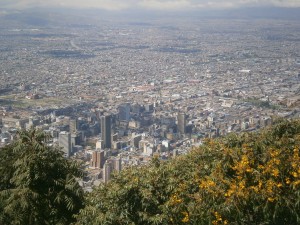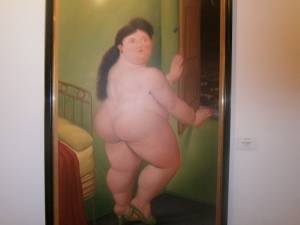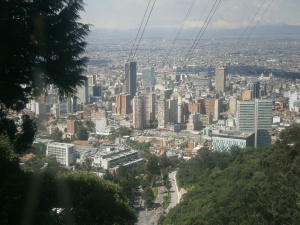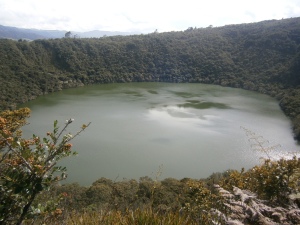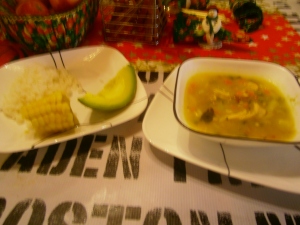Reflections on life on the road
26 weeks of travel, and appropriately enough this is my 26th and final blog post. Rather than try to qualify my thoughts on the travelling with yet more wordy prose, I thought I’d try to encapsulate my journey in a series of lists and stats (those of you who know me well, know that I’m a bit of a “statto”…)
DAYS SPENT IN THE VARIOUS COUNTRIES
Argentina 39
Uruguay 1
Chile 17
Bolivia 20
Perú 12
Colombia 69
Panamá 1
USA 24
ACCOMMODATIONS STAYED IN/ON
Hostels 30
Friend’s apartments 5
Buses 5 (as in overnight bus journeys, including three 24 hour bus rides! I calculate I spent over 170 hours in South American buses in total…)
Homestays 3
Restaurants 1
Pavements 1
MY 5 FAVOURITE CITIES (in no particular order)
Buenos Aires

Crazy, polluted, a little bit dangerous, yet still….Nowhere came close to capturing the sheer verve and passion of this, the first city of my trip. Yes, it may be a little European in style and sentiment, but it wound up being perhaps the “the most liveable city” of my whole trip. It’s a culture lover’s dream, the food is fantastic, the nightlife was the best of my whole trip, and caught in the early days of Spring – the avenidas and parks of the city were gorgeous to walk around. I met some lovely people too, and made some great friends.
Colonia del Sacramento

Yes, it’s more of a museum/tourist piece than an actual lived-in city, but still, and particularly when considered in comparison to its crazy cousin, Buenos Aires across the River Plate, it’s a dreamlike place. It’s a perfectly-preserved paean to the rugged, shipping colonial days of yore, and as I said in my blog piece, walking around the gorgeous streets, plazas and docks, you could almost smell the barrels of rum and port that must have been swishing around this place, centuries before.
Sucre

In the middle of the mountainous, attritional, altitude-plagued and crazy climate of a country that is Bolivia, comes this little oasis. It’s a truly gorgeous city. Perhaps (along with Cartagena) it featured the best colonial architecture of my entire trip, but it was also still authentically Bolivian – just with a more temperate climate and palatable altitude. It helps as well that as the cost of living in Bolivia is so low, Sucre affords the traveller to the opportunity to spend a decent amount of time there, and there are so many cultural and activity-based things to do in and around the city, from little ethnic markets, to mountain and quad-biking.
Medellín

Colombia was probably my favourite country of the whole trip. If you read the final blog piece I wrote there – El último adiós a Colombia – I go into more detail, but in a nutshell, it’s because the country has everything – from an unbelievable diversity of landscape, to a great climate, a variety of fascinating and distinctive cities, and such a vivacious, untamed culture. It became difficult to select just one Colombian place for this list, as I have such good memories of Bogotá, Cartagena and Santa Marta. However, Medellín stands out….It was just such a striking, pleasant, über-civilised city to be based in. I had two spells there, and on both occasions, the first thing that struck me was just how picturesque its setting is, located around a series of mountains, with skyscrapers rising from the valley in-between. The perpetual Spring-like climate is gorgeous, and it’s one of the few places on my travels (Sucre and Los Angeles are the only two other cities) where I truly forgot I was even travelling, and relaxed into the rhythm and ambience of the city.
Los Angeles

Lifestyle-wise, this is as good as it gets. The climate is unbelievable – it’s only February, but in the three plus weeks I was there, it was sunny for all but one day. It’s got great restaurants and bars, it’s a very diverse city with lots of interesting little subcultures and ‘hoods’, it’s great for the entertainment/culture lover, and is right next to numerous other great cities plus magnificent coastline, mountains, lakes etc.
MY 5 LEAST FAVOURITE CITIES (in no particular order)
Travelling is a highly personal and subjective experience, so I make no case for my opinions having any authoritative weight. These are just five places/cities that perhaps disappointed me based upon my expectations prior to visiting them.
Santiago

My feelings about Santiago were undoubtedly clouded by the context of having spent 5-6 weeks in the amazing, ‘larger than life’ Buenos Aires immediately beforehand. But based on my limited time there, I just found the city to be a touch sedate, austere, quite ugly in parts, and seeming to have little cultural core or centre.
Viña del Mar

Viña del Mar’s coastal cousin, Valparaíso, is actually a really interesting, historic Chilean port that was close to making the top 5 cities of my trip, but the celebrated ‘upmarket’, holiday destination of Viña del Mar – just up the coast – was far less charming. It’s a horribly over-developed resort town, full of ugly high-rise hotel developments, and the town centre itself is a grim, teeming mass of unpretty shops and hustlers.
La Paz

Flat out the least appealing city I visited. Extremely ugly architecturally in most parts, filled with an irredeemable air of mania and menace, and with a hostile climate and terrain to boot. The traffic and pollution are awful too.
Cuzco

Any of you that have been following my blog will probably recall my “no holds barred” critique of the way Cuzco and the ‘Machu Picchu’ experience have totally sold their soul to tourism. Don’t get me wrong – the places in their own right remain historically-fascinating – but all the ‘faff’ surrounding it was not to my taste. I just didn’t really enjoy my time in Cuzco, although in retrospect, I think I was perhaps nearing the end of my fatigue with the attritional Bolivia/Perú leg of my tour.
Los Angeles
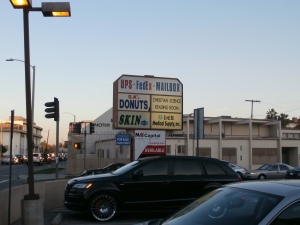
LA is a city that I loved, but also slightly loathed, in equal measure. Perhaps this is more part of an overarching commentary on some areas of (US) American socio-culture I’m less taken in by, but much of the urban landscape is quite bland with its metronomic cacophony of shops, warehouses, and just generally places trying to sell you their wares. Don’t get me wrong – LA clearly has much more to offer than the average US city, but in direct contrast to my previous five months in the endlessly compelling and charismatic continent of South America, it could – at times – feel a touch clinical in comparison.
MY 5 FAVOURITE SIGHTS
Atacama Desert

In retrospect, I wish I’d spent a bit more time here. But still, it’s a fascinating place. It’s the driest desert in the world, host to probably the best star-gazing on the planet, and full of fascinating little towns and developments, as well as possessing great historical ruins and links to the indigenous peoples that lived in the desert terrain in the past. It’s also a mecca for adventure sports – alas I only went as far as mountain-biking – and it’s also the gateway to Bolivia through the curio of a desert town that is San Pedro de Atacama.
Salar de Uyuni

The three-day jeep tour from San Pedro de Atacama in Chile to Uyuni in Bolivia was probably the ‘outdoors’ highlight of my trip. I think there’s something about it being a three-day tour that really makes you ‘live through’ the different experiences and landscapes. In the space of three days you do so much: you cross borders from Chile to Bolivia, you traverse terrain that ranges from desert and mountains, to startling high-altitude lagunas, and you experience life in remarkable, isolated Bolivian outposts. Obviously, reaching the utterly surreal ‘Salar de Uyuni’ with its vista of pure white salt as far as the eye can see, is the apex of the tour, but I prefer to remember the journey as a whole, and the great camaraderie I made with my fellow travellers.
Lake Titicaca

I’ve never really seen anything like it. The world’s highest altitude lake, gleaming in the piercing sunlight, acting as a crossing between the two iconic Andes countries of Bolivia and Perú. Everything about the experience there was memorable – from the lake itself, to the Bolivian town that borders the lake, Copacabana, to the remarkable, historic Isla del Sol in the middle of the lake.
Parque Tayrona

It was one of the greatest frustrations of my trip that I couldn’t spend more time here, but alas poor planning on my behalf, and the small inconvenience of an armed robbery, conspired to leave me with memories of only two abbreviated daytrips to the park. It really is a paradise though – beautifully preserved – featuring some gorgeous scenery and coastline, and containing some of my favourite walks of my travels. A return visit here someday is a must.
Golfo de Urabá

Let’s leave out the city of Turbo, but everything else about this little pocket in the NW corner of Colombia was fantastic. From the utterly memorable (even if in a slightly petrifying way) speed-boat journey across the gulf from Turbo to Capurganá, to my time in Capurganá itself – an Afro-Colombian community that time forgot, to the memorable day’s hike into Panama, taking in some beautiful beaches and epic jungle-walking.
LA Adventures: Part 2
After a first week spent getting my bearings and immersing myself into the everyday life of the Angelino, I made sure that in the time before I leave LA, I make an attempt to fit in all the more classically touristy stuff – Hollywood, Beverly Hills, museums, a hike to the Hollywood sign, and a visit to the gorgeous Santa Barbara, just ninety minutes up the South California coastline.
Perhaps the first mental association people make with Los Angeles is Hollywood and movies, and as you all probably know, I’m a huge fan of cinema, so I’ve been indulging my passion over these last few days. As I write this post, the Oscars are taking place just up the road on Hollywood Boulevard, so I made sure I got involved in the Oscar hype by paying a trip to the heart of Hollywood, and here is the end-result:
I was also lucky enough to get a place on a tour round Paramount Studios, and this was a fascinating insight into how the Hollywood ‘machine’ functions today. It was great to see places where famous movies have been shot, and I walked past Brad Pitt’s motorbike (he was in the sound studios recording voiceover for a movie), but it seems with the industry very much being run by finance guys nowadays, most of the stages and facilities are leased out to long-running TV shows as they’re a greater, and more reliable, source of income for the studio than feature films. Still, it was great to walk on the set of a completely realistic-looking New York City and recall all the times it’s been used in films I remember, and I got to walk through the famous gates of Paramount.
For a more cerebral Hollywood experience, I went to the excellent LACMA (Los Angeles County Museum of Art) where they had a Stanley Kubrick exhibition, and this was perhaps one of the best-curated film exhibitions I’ve ever been to. I think because his wife, Christiane Kubrick, agreed to giving over access to pretty much all of his meticulously archived material, it was great for the film geek in me to see copies of originally drafted screenplays, letters Kubrick sent to and received from famous people (Vladimir Nabokov, Kirk Douglas), and one of the pictures below shows a great recreation of the famous ‘white room’ which featured at the end of my favourite Kubrick film, 2001: A Space Odyssey.
On my walk to the Hollywood sign, I was able to pass by the Bronson Caves, which was where the outdoor bat-cave sequences for the original 60s Batman TV series were filmed (a childhood favourite of mine).
I also made a walk to Beverly Hills, the upmarket district of LA, and passed through Rodeo Drive – the iconic fashion store thoroughfare. Although just a touch out of my price-range, I was able to ‘window shop’ the incredible couture on display from some of the great designers. That Tom Ford suit will one day be mine….
As I’ve discovered over the last three weeks, Los Angeles isn’t just home to the entertainment industry, but is host to a simply perfect climate, and is ideally located near to lots of other great cities and daytrip/weekend-break locations (Las Vegas, San Francisco, San Diego). Having been to all those cities before, I decided to head up the coast to Santa Barbara. Admittedly, this is a very affluent, middle-class city by comparison to LA, but it’s quite simply beautiful. If I die and go to heaven, this is where I hope I end up. I checked out the beach, famous courthouse and old mission, but also went inland into classic ‘Sideways’ wine country territory, past Solvang and Los Olivos, to a winery called Fess Parker – sadly not Rodney’s Winery which was next door (sorry Todney!) I was primed and ready for my, “I do not drink fucking Merlot” line, but thankfully it wasn’t needed….
LA Adventures: Part 1
Los Angeles is a place that defies most of the simplified soundbites and aspersions that many casual observers (both American and not) seek to tag the city with. It’s a place that means different things to different people. Of course, it’s the home of the film and entertainment industries, it’s the centre of the American obsession with all things youthful, holistic and ‘beautiful’, and it also represents the apotheosis (or should that be ‘end-game’?) of the American love-affair with the automobile with its cacophony of roads and highways chugged with traffic. However, before one gets too pre-occupied with this stereotypical view of LA – some of which is true, some less so – let’s not forget that LA is also the gateway to the US for many immigrant groups, and also what is “Los Angeles” anyway? In essence, outside of downtown and Hollywood (the ‘real’ city of LA), it’s essentially just a county host to lots of other cities and communities – many of which don’t mesh with the abbreviated view of the city I mentioned above.
My first week and a bit in Los Angeles have given me the perfect tool to investigate the breadth of different locations and cultures in the city. I’ve been staying with friends in apartments either side of the “Hollywood Hills” – my first few days were spent in Studio City, out in the famous San Fernando Valley (view of the ‘Valley’ from Fryman Canyon below).
As betrayed by the name ‘Studio City’, this is located near to many of the famous Hollywood studios and Burbank, and I guess the closest I came to movie celebrity-dom in this neighbourhood, was passing through the famous ‘Mulholland Drive’ (David Lynch fans will know what I’m talking about), hiking past one of George Clooney’s residences on the walk up to the spot where I took the above picture (photos not allowed), and meeting a friend of my host who owns a boutique fashion store on Ventura Boulevard where many famous actors go, and where Kelly Clarkson had just been on a $1500 spending binge after winning an award at the Grammies.
My second spot of accommodation was on the Miracle Mile, a nice locale more centrally-located in LA, and a short trot from Hollywood and Beverly Hills. As I speak, I’m still exploring this area – it’s near to some of LA’s best museums (below is a picture of the Los Angeles County Museum of Art, LACMA) – so I can update more on my next bulletin.
As mentioned earlier in my blog, there is an LA away from the stereotypical, and I saw much of it this weekend. In the space of a few hours I took in many of the ‘ethnic’ neighborhoods: Chinatown (again a famous place for us movie buffs), Olvera Street (essentially a ‘Little Mexico’ in downtown LA), Thai Town and Little Korea. In addition, I went to a number of iconic buildings designed by the great Frank Lloyd Wright, and I took in the Griffith Observatory – an elevated part of central LA that takes in great views of the city, including downtown and the Hollywood sign. See below for some pictures of this jaunt….
Enough of the high-minded fence-sitting though….what do I actually make of the city on a personal level? Well, I have to put it in the context of the fact I’ve just spent over five months backpacking round South America. For the first day or so, the relative ‘order’ or tranquility (I know – not a word one readily associates with LA) was a pleasing antidote to my final, hectic few weeks in Colombia. I’d also overlooked that I’d finally be stepping back in a country where English was the first language – although Spanish is used a lot in LA – and it was a nice ‘reward’ after the challenges of having to rely completely on my Spanish which I’ve essentially built up from nothing since I arrived in Argentina back in early September. Los Angeles has everything ‘lifestyle’-wise you could wish for – great food, great shopping and also a truly wonderful climate. The climate alone must be reason enough why many people choose to live in SoCal – considering it’s technically still ‘winter’ here, the mild, temperate sun is absolutely gorgeous. I enclose below a few snaps of the places I’ve been enjoying and ‘hanging out’ in over the last few days.
Alas, it only took a few days, and I’ve already begun to miss South America – especially Argentina and Colombia. Those countries have such an incredible vivacity, spontaneity and ‘authenticity’ of culture that the clinical boulevards of LA couldn’t possibly replicate. As I’ve observed before on my visits to the US, the country’s landscape really is a paean to the market economy – almost everything is about commerce, consumption and the ‘sell’. I think the below picture sums up this essential truth so well – a little street corner that sells you donuts, skin treatment, and a “Christian Science” reading room all side-by-side….”only in America”.
All Roads Lead to Where I Stand: El último adiós a Colombia
Esta es mi última columna de mi blog en Sudamérica, entonces voy a probar a escribirlo en Español y Inglés. Disculpas por adelantado por mi Español…
This is my last blog piece in South America, so I’m going to try to write it in Spanish and English. Apologies in advance for my Spanish….
Ha pasado un gran tiempo desde mi última actualización, pero desde yo tomé la decisión de no continuar a Panamá, he estado volviendo a mi lugares favorito en Colombia – y escribiendo mas.
Después de mi viaje al Golfo de Urabá y Panama, volví a Cartagena, y la ciudad parecía mas tranquila que la manía de Año Nuevo. Yo necesité solamente un hostal este tiempo, y empecé a conocer la ciudad mucho mas. Visité las playas en la ciudad (Marbella y Boca Grande). Marbella estaba agradable – las olas eran buenas – y después, en el centro, vi la puesta del sol al Café del Mar.
Boca Grande – el paraíso de los ricos en Cartagena, no me gusta tanto. La playa no es muy buena, y hay muchos mendigos y vendedors. La playa mejor en Cartagena necesita un viaje en barco de sur oeste de la ciudad – es en la Isla del Barú y se llama Playa Grande! Yo hice este viaje y no fui frustrado. La playa es hermosa, no hay mendigos, y hay vistas espectaculars del mar. Afortunadamente, no estaba inferma como mucha gente en Barú a este tiempo….En Cartagena también, yo pasaba el tiempo mejor en mi viaje para socializar, y pasé los días y las noches muy divertido/as! Mi tiempo en Cartagena era un barómetro muy interesante para mi Español. No soy fluido, pero mi Español es avanzado, y extrordinariamente, muchas personas creían que fui de Argentina porque de mi Español y porque mi bronceado es mas sudaméricano que los gringos y europeanos!
Quedando en una ciudad por mucho tiempo, puede encontrar pequeñas “joyas” que no es obvio a los turistas. Teniendo un presupuesto muy económico, yo iba muchas veces a Firos Pizza. Es una pizzeria buena, donde puede tomar dos porciones de Pizza y una gaseosa por menos que 5000COP (2GBP). Yo también encontré un restaurante de cocina India en Getsemaní – esto me hizo muy feliz! Puedo recomendar el hostal “Media Luna”. Es un poco el hostal para la “fiesta”, y hay muchos Argentinos y Chileños en sus vacaciones, pero me gusta este hostal: es barato, tiene un diseño agradable, y es bueno para un mal durmiente como yo.
Después de Cartagena, mi intención era a pasar diez dias en Parque Tayrona y La Guajira. Desafortunadamente, mi bus entre Cartagena y Santa Marta fue robado cerca de Barranquilla, entonces la mayor parte de mi tiempo en Santa Marta pasaba tratando de resolver el problema grande de administración que yo tenía (los ladrones “me gustaron” mucho, y robaron todos mis posesións a punta de cuchillo)….Pero, mi tiempo en Santa Marta confirmó mi cariño por la ciudad – y quizá yo prefiero Santa Marta mas que Cartagena. La gente parece más amigable, mas tranquilo, y como yo dije en Diciembre – hay un ambiente agradable y parece “auténtica” afro-caribeño. Tristemente, tuve solamente tiempo para un viaje corto a Tayrona, y fui a Arrecifes, La Piscina y Cabo San Juan (otra vez). El parque es absolutamente mágico, y conservado muy bien. Voy a volver a Tayrona/La Guajira/Sierra Nevada un día, porque tengo “unfinished business” con esta parte del mundo!
Entonces, estoy en Medellín ahora, esperando para mi vuelo a los Estados Unidos en dos días. Cualés son mi sentimientos de Colombia? Porque yo pasaba mas que dos meses aqui….Me encanta este pais, y él tiene todo: ciudades fantasticas, pueblitos bonitos, la selva, las montañas, un clima diverso, increíble costa (con el mar carib y el océano pacífico), parques hermosos, la vida nocturna buena, y es un de los pais mas diverso en Sudamérica.
Yo creo que es un pais muy cerca de un grande adelanto en el mundo. Muchas personas piensen que Argentina es el segunda “fuerza” del Sudamérica debajo de Brazil, pero Colombia tiene una población mas grande y una economía mejor (pero lo no es dificil!). No se olvide también que Colombia es un gran pais (el mismo tamaño de Francia, España y Portugal). Puedo ver una situación en la próxima décade cuando Colombia es el rival de Brazil y Mexico para el mas gran turismo en Latinoamérica….Pero, como alguno pais, Colombia tiene problemas, y particularmente después de el robo dejóme necesitando ayuda, yo vi muchos casos de la corrupción y la ineficiencia (mi reunións con la policia fueron ‘interesantes’). Y, aunque la desigualdad social y fiscal no es exclusivo a un pais, Colombia tiene ciertamente una enorme división entre los ricos y los pobres. Por ejemplo, Cartagena – el “Old Town” es un lugar mágico, para ser disfrutado para los turistas y Colombianos affluents, pero lejos de las murallas hay una ciudad muy, muy pobre – y la gente afligió es los negros. Y en Bogotá, donde recibí la hospitalidad muy gente, la población affluent (incluyendo mis amigos) – para mi – vive en una forma de “siege mentality” o la negación colectiva de la realidad de su pais. Ellas nunca salen sus apartamentos, universidads y centros comerciales qui son patrullan 24/7 para la seguridad, y saben mas de viajar en los Estados Unidos o Europa que en su proprio pais. Mis amigos fueron sorprendidos cuando les dije que voy a viajar para bus en su pais hermoso – no porque piensen que es peligroso ‘per se’, mas que ellas no pueden concebir de esto. Por supuesto, yo no evito las problemas de seguridad en Colombia que quedan hoy, y también, no evito el legado de interferencia del pais en el oeste (particularmente los Estados Unidos). Pero, espero de oír (y ver) sobre un pais mas seguro y autónomo en los años siguientes.
PS – He amado mi tiempo aqui, pero las cosas que no voy a extrañar: Aguardiente, Carlos Vives, y escuchando “amigo” cada vez que yo camino en la calle – preferiría “caballero”!!
ENGLISH
It’s been a while since my last update, but in truth, since making the decision not to continue north through Panamá, I’ve essentially been re-treading my steps through many of my favourite places in Colombia – plus making time to do more writing….
After my trip to the Golfo de Urabá and Panamá, I returned to Cartagena, and the city had certainly calmed down a touch after the mania of Año Nuevo. I was able to bed myself into a single hostel this time, and really got to know the city a whole lot more. My first stop-offs were the city beaches of Marbella and Boca Grande. Marbella was actually fairly pleasant – the waves were surprisingly good – and it was only a short cab ride back to the Old Town and the famous Café del Mar to catch the spectacular sunset over Cartagena in the evening.
Boca Grande – the high-rise ‘playground’ of Cartagena was less to my liking – and the beach was pretty poor, especially as there’s a non-stop barrage of beggars and various ‘vendors’ trying to sell their questionable wares. The best beach is actually a boat-trip south-west of Cartagena, to the Isla del Barú and the famous Playa Grande. I made this trip and – suffice to say – I wasn’t disappointed. A pristine beach, little interference from hustlers, and spectacular views out to sea! Amusingly, there was a serious stomach virus going round the travellers in Barú, but fortunately I seemed to avoid it….I’ve also had probably the best social time of my trip so far in Cartagena. I’ve made some great new friends and had some enjoyable days (and nights) out. Spending time in Cartagena was also a great barometer for how much my Spanish has improved. I wouldn’t say I’m fully fluent, but my Spanish is pretty advanced now, and bizarrely – because of my competent Spanish and the fact I have a darker skin-tone than most of the other Europeans/Gringos – I was mistaken for an Argentinian on many occasions!
Staying in a city for so long, you really get to know the little quirks or hidden gems that perhaps aren’t obvious to the passing traveller/tourist. Being on a strict budget, I was a regular frequenter of Firo’s Pizza just inside the Centro district. It’s a cracking little authentic, local pizzeria that serves you two great portions of pizza, plus a soft drink, for under 5000COP (less than 2GBP). I also found an Indian restaurant in Getsemaní, and as a Brit who has gone without Indian cuisine for well over five months, I savoured the excellent curry they provided there. As for hostels, I can recommend the Media Luna hostel. It’s a little bit the “party hostel” of Cartagena – full of holidaying, wealthy Argentines and Chileños on their summer breaks – but it’s a great hostel: affordable, beautifully laid-out, and for a light sleeper like me – the dorms are spacious and brilliantly designed.
After Cartagena, my plan had been to spend ten days back exploring Parque Tayrona and La Guajira. Alas, my bus from Cartagena to Santa Marta suffered an armed robbery just outside of Barranquilla, so most of my time in Santa Marta was spent trying to extricate myself from the bureaucractic/logistical headache this left me in (the robbers took a “liking” to me, and pretty much relieved me of all my worldly possessions at knife point)….Still, my time in Santa Marta confirmed my fondness for the place after the days I spent there in December. In some ways, I actually prefer it to Cartagena. The people seem friendlier, more relaxed, and as I’ve said before – it has a nice, authentic Afro-Caribbean feel to it. I only had time for one more day trip to Tayrona, taking in Arrecifes, La Piscina and Cabo San Juan (again). The place is absolutely magical, beautifully preserved, and I definitely feel I have some unfinished business with this part of the world that will warrant a return visit one day.
So, here I am in Medellín, awaiting my flight to the US. What are my reflections on Colombia? After all, I’ve spent over two months here….Well, the country has it all: great cities, beautiful villages, jungle, mountains, a diverse climate, amazing coastline (straddling both the Pacific Ocean and Caribbean Sea), lovely national parks, a very strong cultural identity, cracking nightlife, and it’s one of the most ethnically diverse countries in South America.
I sense it’s a country not too far away from being on the cusp of a major breakthrough on the world stage. People often think of Argentina as South America’s ‘second major power’ after Brazil, but Colombia actually has the larger population and better economy (although that wouldn’t be too difficult!) Don’t forget as well that Colombia is huge – the size of France, Spain and Portugal combined. I can forsee a situation where Colombia rivals Brazil and Mexico as Latin America’s prime tourist destination in the next ten years….However, like any country, it has its problems, and particularly after my robbery left me on the “wrong side” of the tracks, I was witness to staggering acts of inefficiency and corruption (my encounters with the police were, how shall I put it diplomatically, ‘interesting’). And though social/fiscal inequality is a problem not exclusive to any one country, Colombia definitely has stark and unwholesome divides between the “haves” and “have nots”. Cartagena is a case in point – the Old Town is a fairytale playground to be enjoyed by the affluent Colombians and tourists who go there – but step outside the city walls, and you encounter a teeming sprawl of urban poverty primarily afflicting the black population. Even in Bogotá, where I was fortunate enough to receive lovely hospitality back in early December, the affluent population (including the friends I stayed with) seem stuck in some form of unacknowledged “siege mentality” or collective denial/amnesia about the reality of the country around them. They rarely leave their security-patrolled apartments, universities, office blocks and shopping malls, and know more about holidays in Europe and the US, than they do about travel in their own country (which only extends to summer holidays in Cartagena). Suffice to say, they were staggered when I told them I was going to be backpacking and bussing my way round their beautiful country – not so much because they perceived it to be dangerous per se, more that they simply couldn’t conceive of it. Of course, I don’t ignore the longstanding security problems in the country – still pretty much extending to the present day – and I don’t neglect the part Western/US governments have played in blighting Colombian politics and social development over the decades. However, I fully hope/expect to see and hear about an evermore secure, confident and autonomous country in the years to come.
PS – I have truly loved my time here, but the things I won’t miss about Colombia: Aguardiente, Carlos Vives, and being serenaded by the cries of “amigo” every time I walk down the street – surely “caballero” would be a fairer description!
*Apologies, but for the first time, none of these pictures on this post are mine, due to the robbery. I have pilfered them from friends and the internet!*
Año Nuevo in Cartagena and the Golfo de Urabá
Despite my friend being stuck in Venezuela for New Year’s Eve, I decided I wasn’t going to go back on my original plan of spending it in Cartagena (or Cartagena de Indias to give it its full name).
Cartagena is stunning – a feast for the eyes – and perhaps the most purely beautiful city in South America that I have been to. The Old Town is almost too handsome (if that’s possible), with its chocolate-box array of gorgeous colonial architecture, horse-drawn carriages carting tourists around, and great historical sites surrounded by Las Murallas – thick walls that protect the Old Town. Ironically, many of the walls and forts of the city were constructed in the wake of our very own Francis Drake laying siege to Cartagena in the late 1500s. But don’t feel too sorry for the Spaniards as they were using the port/city primarily as a place where they stored treasure plundered from the continent’s indigenous people….
Alas, I had underestimated just how popular Cartagena is at this time of the year. I arrived in a rather blasé fashion on December 30th, assuming I could just rock into a hostel, as I had done in every other South American city I’d been to. Oh no! Cartagena – as well as being a very beautiful place, and extremely busy (many Colombians and South Americans holiday at Christmas and during January) – is perhaps the most exclusive South American city I’ve been to. Basically, if you can’t find a bed in one of the very sparse hostels in the Getsemaní district, then good luck trying to find anything below about $100,000 Pesos per night in the Centro/San Diego districts. So, rather amusingly (but tiringly), I stayed in four different hostels in the four nights I was in Cartagena – trying to sniff around for a spare bed or a better price. I include the below picture, not to showcase my magic physique, but also to show how poor some of the accommodation was. If I wasn’t staying in a de facto brothel one night, it was a dorm crammed with about fifteen people on the next night! Funny to look back on, but hard work at the time….
Fortunately, between looking for hostels, I did find time to enjoy New Year’s Eve (Año Nuevo) in Cartagena! It wasn’t quite the same as it might have been with Essjay, but I still managed to find some drinking chums in my hostel, and luckily New Year’s Eve is very much played out on the streets of Colombia, so we just grabbed some beers and flocked to the Puerta del Reloj (clock-tower) to watch the clock strike twelve and the fireworks kick-off….
I also saw some Colombian dancing in the main Plaza de los Coches. I like the below picture, as it captures the costumes (Colombian colours) in full flow….
And for my last night, I was able to find a really nice hostel that offered a great view down on to the Plaza Fernandez de Madrid.
After Cartagena, I was looking for something completely different, and the Golfo de Urabá offered precisely that. Wedged right in the south-west corner of the Caribbean Sea, it’s the area of Colombia that connects with Panamá. Because it’s impossible to cross the border from Colombia to Panamá by land (although ironically I did this), the only options open are to fly between the two countries (expensive, particularly at this time of year), take a sail-boat (again, an extremely expensive option), or take a DIY version, where you bus it from Cartagena to Turbo, get a boat from Turbo to Capurganá, then another boat from Capurganá to Puerto Obaldia in Panamá, before flying on to Panama City. Although I now had serious doubts about whether going to Panamá was going to be a viable option (more info on this later in the blog), I decided to head to Capurganá anyway, as it was meant to be the hidden gem of Colombia’s Caribbean coast, and would be the best place to make a decision about Panamá.
The first stop on this journey was easily the least palatable. In contrast to all the amazing places on the Golfo de Urabá, the first city – Turbo – is probably the least lovely place I’ve been to in Colombia, if not South America! It’s a necessity, because it’s the maritime gateway to the rest of the Golfo’s coastline, but it’s a dirty, dangerous, untamed port city – a former paramilitary stronghold – and although I’ve always ignored the generic, touristy comments about ‘safety’ in South America, this is the first time I’ve generally felt a bit worried, especially as my bus dropped me off past midnight in the centre of the city. As you can imagine, I was keen to “turbo” out of Turbo, so I got up early the next morning to get the speed boat across to Capurganá.
The boat journey is something else. Two-and-a-half hours of bone juddering acceleration across the Golfo. I know many of the passengers (especially the few tourists that were on it) hated it and got really nauseous, but I personally loved it. A real 2.5 hour joy-ride. And you get really wet – hence the lifejackets and the bin-liners covering all the bags!
It was all worthwhile when I arrived in Capurganá though. It’s the “thinking man’s Taganga” – a pristine Caribbean fishing village, almost untouched by tourism and the outside world. It has a lovely Afro-Caribbean feel to it – in terms of the pace of life and the music that was blaring out of the many shops and bars – and the proximity of beach to jungle was spectacular. Interestingly, there are no motor vehicles in Capurganá – horse and cart still reigns supreme here – although there is one incredibly DIY airport that ferries food and water to the town’s citizens.
My hostel was ‘interesting’. A lodge right in the middle of the jungle, on the outskirts of the village. The mosquito-nets were certainly needed, and it was eventful trying to walk back to the hostel, when the power went out in the village, as it always does, at midnight.
Below are a series of pictures of Capurganá that summate the lovely 3-4 days I had there. Hover over the pictures for more of a commentary….
All that remained was for me to do the famous jungle hike to the next town up the coast (Sapzurro) and – if I wanted – La Miel, which is inside Panamá. By now, I had decided that I wasn’t going to be venturing any further into Panamá or Central America. I couldn’t get a flight to Panama City before the middle of January, and flights to LA (my final destination) are more prohibitive if I do them from San José (Costa Rica) or Panama City than if I make them from Bogotá. I also have bureaucratic problems – Panamá might have issues with me entering from Colombia without a Yellow Fever certificate (it was stolen in Bolivia). Plus, I feel that I would now be racing through Panamá and Costa Rica, not really doing them justice – so, why not come back and do a proper journey through all the countries of Central America (Mexico all the way down to Panamá) another time? Also, it means I have more time to see the places of Colombia I really didn’t do justice to – Parque Tayrona, La Guajira – as well as finding time in the bigger cities to do some more writing.
So, with that in mind, I was keen to walk to Panamá, knowing I wouldn’t be going any further into the country. The walk is an attritional 2.5 hour hike up a mountain and into the jungle. Horses line the route….
Finally, I made it to Panamá, and La Miel was a great place to remember Panamá by – a gorgeous beach-town, completely untouched by time.
So, it’s back to Cartagena, to see if I can finally snag a hostel bed now that New Year’s Eve is long gone, and to plan my next month of “lying low” in Colombia. Lots of swimming in the Caribbean Sea, lots of writing, and lots more to discover in this great country….
Santa Marta, Taganga, Tayrona
Santa Marta – where South America meets the Caribbean. Where the lowering peach-tinted horizon chimes with the pink and blue neon lights that shimmer in the balmy, tropical air. Where salsa and reggaeton are the perennial rhythm to the city’s beating heart, and where copious amounts of succulent fresh fruit and fish line the beach-front stalls.
My first stop on Colombia’s Caribbean coast saw me spend a few days in Santa Marta. Most travellers pass through Santa Marta on the way to the tourist-friendly resort of Taganga just up the coast (more on Taganga later), but I decided to spend a few days in Santa Marta. I actually grew extremely fond of Santa Marta. It really feels like a “lived in” city to me, not troubled too much by tourism (not from foreign travellers at least) and full of the cadences of Latin/Caribbean life that I mentioned in my first paragraph. The weather is gorgeous – a perfect, consistent dry heat – there are spectacular sunsets over the Caribbean Sea, and I think symbolising Santa Marta’s no pretensions functionality is the fact that the city’s port is pretty much on the beach.
Santa Marta has an interesting history too. It’s the oldest city (at least in colonial eyes) in Colombia – a statue of its founder, Rodrigo de Bastidas, lines the beach-front (see below). Santa Marta is also where Simón Bolivar died, and it boasts a decent gold museum which I visited (I missed the similar versions in Bogotá and Medellín).
After a few days in this lovely, authentic coastal city, I went to its polar opposite – Taganga – the backpacker haven and small Colombian fishing village just up the coast.
I have a “love-hate” relationship with Taganga. On the plus side, the location is magnificent – there are some truly amazing vistas out across the bay – and a few minutes’ walk along the cliffs from Taganga are some fantastic little coves and beaches where I was lucky enough to have some fantastic swims and watch fishermen ply their trade. On the negative side though, the place seems hopelessly overwhelmed by the influx of tourists and travellers. It’s an awkward, loud, unseemly marriage of a provincial Colombian fishing community, with the various ‘outputs’ of tourists – some of which are understandable and benign (it’s a gateway to the Parque Tayrona and a great place to go swimming and diving), versus the more ‘questionable’ (it’s a weed-lover’s dream, a hippy haven, and pumping techno clubs on the beachfront overpower the smaller, local Colombian restaurants and bars). And don’t get me wrong – I’ve got nothing against hippy culture and ‘alternative living’ per se – but this lot in Taganga are probably the least politicised and intellectual I’ve ever come across. If you’re going to be a hippy, at least be interesting, and give something back to the community you’re in! They only seem to be here because it’s a pleasant and cheap enough place to be doing nothing, and they can score copious amounts of marijuana….
Anyway – back to my Taganga routine. Well, I was fortunate enough to make a couple of friends in my hostel, and we saw Christmas Day in dancing to salsa in a bar overlooking the village.
I’ve always dreamed about spending Christmas away from the cold, bleak environs of the UK – and Taganga afforded me that wish. My Christmas Day was very simple: I woke up, hiked to the secluded beach I favour, swam and sun-bathed for most of the day, then dinner and dancing in the evening. Simples! Most of you will have seen my new cover picture on FB which showcases the Taganga evening vista, but here is an alternative for those that haven’t:
As mentioned, my favourite swimming spot was a secluded cove I shared with fishermen. It was fascinating to watch them cast their nets, and at 5pm every evening, pull the nets in to see what sort of catch they’ve got. The below pictures represent that cycle….
I also found time to play beach football with one of the local lads!
After a day at the beach, what better way to refresh oneself than with an amazing ‘fresh’ fruit juice drink, as per the below montage!
Idling my time away in Taganga, I had left myself criminally short of time to see the beautiful Parque Tayrona, so I shuttled off there today for a whistlestop one-day tour/drive, stopping at Cabo San Juan (a truly amazing beach) for a couple of hours. A local lady I encountered on the beach allowed me to take pictures of her:
Alas, another ‘setback’ to my travels occurred this week. And when I say ‘setback’, it’s not really a setback for me, but my friend Steve (‘Essjay’ to many of you!), who was due to meet me in Santa Marta this week before we headed to Cartagena for New Year’s Eve, has found himself marooned in Venezuela. Apparently no bus companies are running services to Colombia from Venezuela until January 6th, so that pretty much scuppers our plans for Cartagena. I’m pretty gutted as it was my one opportunity to spend some time with a friend from home out here, but to look at it philosophically, at least Essjay seems to be making the best of it in Venezuela, and ‘the show must go on’ for me. I now found myself with a quandary: Do I head on to Cartagena irrespective and act like a “Billy No Mates” on NY Eve, do I hang out in Taganga for a bit longer, or now I have more flexibility shall I investigate Tayrona some more? Stay tuned to find out….
Medellín: City of the Eternal Spring
My stop-off between Bogotá/Zona Cafetera and Santa Marta/Cartagena has been the Colombian city of Medellín. It’s probably best known to most amateur observers as “The World’s Most Murderous City” in the late 80s and early 90s – a time when drug cartels (including that of Pablo Escobar) overran the city. In the last decade or so however, it has reinvented itself as a real Colombian success story. I remember going to an exhibition in Paris last year which celebrated the sociological thinking behind Medellín’s recent urban transformation: The first (and still the only) Colombian metro system was constructed in Medellín (picture below), and space was set aside for new municipal buildings (libraries and museums), parks, botanical gardens, and modern art constructions.
It gives Medellín the vista of a very striking, modern metropolis, particularly when set against the surrounding mountains (a feature it shares with Bogotá).
Medellin also has the steady year-round temperatures that Bogotá has, with one subtle difference….As betrayed by its nickname “The City of the Eternal Spring”, Medellín has an ultra-pleasant climate, never too cold, never too oppressively hot, and usually between the late-teens and early-twenties Celsius. It’s probably the first place I’ve been in South America where I’ve gone days without being subject to stratospheric extremes in temperature!
Anyway, I followed the guidebooks, and went to the tourist barrio in Medellín of El Poblado to rest up and find a hostel. It’s simply exhausting to have the mindset of a traveller seven days a week, for the whole six months I’m away, so it’s a compliment to Medellín that I had earmarked it as a place where I’d feel comfortable to jump off that treadmill for a few days, and almost forget I’m travelling. Add to that, a laptop was now back in my possession, so I designated this as my second “Week of the Ghost” (a la Reñaca in Chile), so I could catch up on my writing projects, and save my energies for what I imagine will be a full-on Christmas and New Year period on the Caribbean Coast in Santa Marta and Cartagena. El Poblado is full of decent (if a bit pricey) coffee shops and restaurants, and at night it becomes another “Zona Rosa” with its plethora of bars and clubs. My hostel had a decent mix of locals and travellers, so as a group we had one night bar-hopping, and there really was a mish-mash of musical influences pumping out of the speakers of El Poblado. One bar will have full-on Reggaeton playing, others stick to more familiar Euro-American commercial dance, while others play good, old-fashioned Salsa. Although not in the official capital of Salsa – which is Cali – it was still good fun to try it in a bona fide hot and sweaty Colombian nightclub, and it gave me great pleasure to be substantially better than the other European/Gringos in the group! I was also in a club where a middle-aged chap just crashed on one of the sofas for the entirety of the night. A truly bizarre sight, although a similar thing happened at a house party I went to in Bogotá two weeks ago, when the ‘father’ of the family slept through the whole proceedings…Life is a bit tough for the Colombian men of today?
I did venture from my laptop for long enough to acquaint myself with the city, and I was particularly impressed with the Botanical Gardens which I thought were more impressive than the Bogotá version. They had a really decent collection of exotic butterflies (if you like that kind of thing?!) where you could get up really close to them…
The Botanical Garden also had clever newspaper mountings of famous moments in Colombian history, and I remember this one when Colombia thrashed Argentina 5-0 in 1993 (in Argentina) as part of qualifying for the World Cup the following year in the US. Of course, Colombia would go into that tournament as one of the favourites, before a certain Gheorghe Hagi put paid to their chances!
There are some great museums in the centre of Medellin – perhaps the best of which is the Museo de Antioquia that offers a whistlestop tour through the region’s history from pre-colonial times to the present day.
I couldn’t let my time in Colombia pass without comment on all the fruit that is grown here. The country really is a fruit-lover’s delight. There are fresh-fruit/smoothie shops everywhere, and even street-sellers have fantastic, fresh, local produce – check the great variety of fruit below!
Also, although I’m enjoying a low-key (non-existent) Christmas this year, it’s hard to avoid the spectacular Christmas lights in Medellín. The below is just an example in the Parque Lleras – a stone’s throw from my hostel.
Zona Cafetera
Before I arrived in the Zona Cafetera, I had one final night in Bogotá, and I happened to pick the special night where the Colombians light candles to mark the beginning of the Advent period – la Día de las Velitas. Again, I didn’t bring a camera to commemorate this, but suffice to say it was impressive, and just generally the Christmas lights in Colombia are as good as I have seen anywhere. Bogotá was amazing, but I just arrived in Medellín this afternoon, and I think it trumps even Bogotá (pictures to come in my next post!)
So, I caught a bus from Bogotá to Armenia, and it took in some of the beautiful Colombian countryside. In some respects, the Colombian landscape is even more beautiful than in Bolivia or Peru. Because it’s by the Equator and gets an awful lot of rain, it’s really green and lush – you could almost mistake it for England, if it wasn’t for the vegetation being much more tropical!
To the average tourist perhaps, Armenia is nothing special – just a large town in the Zona Cafetera district, and the gateway to the more popular locations of Salento and the Valle de Cocora. However, part of the pleasure of my travels has been in not becoming obsessed by ‘ticking off’ all the recommended tourist sites, but in taking time to immerse myself, and simply ‘be’, in the regular towns and cities I’ve passed through. Incidentally, in Armenia, I’m pretty sure I just stayed in my first one-star hotel! But as Tyler Durden says in Fight Club, “hitting rock bottom isn’t a weekend retreat!” Who needs 5* hotels anyway, when there’s a 1* round the corner….
After Armenia, it was on to Salento, and I approached it with some trepidation, after the tourist horrors I encountered on the way to Machu Picchu in Cuzco and Aguas Calientes. After Cartagena, Salento is the most visited ‘tourist site’ in Colombia, famous as the place to be for coffee plantation tours, and I have to say I really found the place enchanting – a fantastic contrast to the great (but very ‘urban’) charms of Bogotá. What I particularly liked was the way that the local Colombian populace haven’t sold their soul to the tourist hordes. Walking around the picturesque village and its lovely square, the locals get on with their lives and business as if the tourists weren’t even there. That’s not to say that Colombians aren’t polite – in fact, they’re probably the most genuinely pleasant people I’ve come across in South America so far – they’re just happy to keep themselves to themselves!
I stayed in a fantastic hostel on the edge of the village, called Plantation House. It really was like being out in the jungle – just a simple hut contained my bedroom and bathroom. Obviously, the centrepiece of my stay in Salento was a tour of a coffee plantation, and luckily my hostel had a huge plantation on site.
What follows below is a bit of a description of what I gleaned from the tour.
Below are the three main coffee beans grown on site. They’re all Arabica beans, but the different colours reflect different flavours and different strength coffees.
Incidentally, the plantation was so huge and bountiful, that they also grow fruit on the site. Below are pictures of the pineapples and oranges to be found….
The plantation was also teeming with cats and dogs (you may have seen I posted a picture of an exceedingly lazy cat on my FB page!) Well, this dog wouldn’t leave my side the whole tour. I even tried to feed him an orange after it fell off the tree!
Anyway – back to the coffee process. Well, after the beans are picked (and they’re picked only by hand – so as not to damage the fragile plants), they are peeled, then aired/sunned for about a week – see below.
After the beans have been sunned, all that remains is for them to be roasted….
….then ground.
The below picture reflects the evolution of the coffee process in its entirety.
All that remained, was for our supremely fresh cup of coffee to be served, and then we took our drinks out for spectacular views of the surrounding valley as sunset came. Not a bad way to spend a Monday!
Bogotá, Zipaquirá & Guatavita
So, after nearly three months of travel exclusively by land, I took my first flight last week, and went from Lima to Bogotá (sadly cutting out Ecuador) in one fell swoop.
As I always seem to do when I arrive in a big city, on my first full day, I tried to get my bearings, and this was made easy by my accommodation being located just off the middle/northern-end of one of Bogotá’s major thoroughfares – the Septima. Walking down the Septima I was able to get a feel for the city, and I slowly made my way down to the Plaza de Bolivar (picture below) and the centre of the city.
Bogotá really is host to some great culture and museums, and on that first day I visited among other things the Museo Nacional (a great introduction to Colombian history) and the Quinta de Bolivar – former home to the great Latin American liberator, Simon Bolivar (again, see below picture).
I also visited the Donación Botero – home to some of the works of one of Colombia’s best known contemporary artists, Fernando Botero. His work is ridiculously satirical and revels in grotesque depictions (usually of fatties), but the gallery also featured other great artists, including work from one of my favourite painters, Francis Bacon. Anyway, here’s a classic Botero picture below….
The Donación Botero is located in the colonial quarter of Bogotá – La Candelaria – and this is a lovely, pleasant part of town, full of cafes, museums, cobbled streets, and beautiful painted buildings.
Incidentally, while I was walking through Bogotá, I was caught in one of the many rainstorms the city has, which brings me on nicely to talking about the city’s climate. After some pretty intense weather in Chile, Bolivia and Peru, Bogotá has acted as a pleasant contrast. Basically, because Colombia is very near the Equator, many of its cities don’t have seasons as such, their temperature and climate remain constant throughout much of the year. As Bogotá is very high up (over 2500m), and flanked by mountains, it’s temperature rarely gets above 15 degrees Celsius for most of the year, and – reminding me of my time as a student in Miami – it always seems to rain at least once every day (usually in the late afternoon). As Bogotá is a really bustling, ‘jumping’ city as it is, add to that the low, brooding storm clouds never far from the horizon, and that vista filled with imposing green mountains around the city, it makes for quite an evocative atmosphere.
To honour that atmosphere, I went to the most famous peak perched above Bogotá – the Cerro de Monserrate – which houses a gorgeous white church at its summit. The two pictures below show the image of Monserrate from below, then the brilliant views it offers of Bogotá once you’ve scaled it!
I also found time to go to two really interesting sites just to the north of Bogotá. The first was Zipaquirá – an amazing underground cathedral that was converted from an old salt mine. It was really impressive to follow the immensely creative way that the designers have come up with different sculptures to mark the Stations of the Cross. To give an idea, if you’ve been to Jameos del Agua in Lanzarote, then the atmosphere of Zipaquirá is similar (see below pictures).
Then, half-an-hour away, was the famous Laguna de Guatavita. A sacred lake for the indigenous Muisca tribe, and birthplace of the El Dorado myth. It was here the Muiscas made offerings to their gods, and as well as food and emeralds, they also threw gold into the lake. Acting as microcosm for the wider plundering that was occuring in Latin America, when the Spanish colonialists came here they tried to recover the gold – from diving in the lake to collect it (invariably unsuccessful) to even attempting to drain the lake at one point. The lake itself is unique. It’s fed neither by the sea, nor by rivers or tributaries, instead it was a by-product of a seismic shift in tectonic plates millions of years ago, creating among other things the Andes, and shoving this lake high into the mountains. Have a look at the below picture. As you’ll see, it looks a little like the crater volcano-lake in You Only Live Twice, and the tourist path takes you high above the lake, presumably to ward against anyone foolish enough to try and jump in!
I’ve also tried to sample some authentic Colombian cuisine in my first week here. I was plied with some Canelazo on my first evening here (a hot spicy alcoholic drink – not a million miles away from mulled wine), and I’ve also tried Ajiaco (a typical Colombian soup of chicken and potato) and Rosconería (a delicious pastry) – see below pictures for both.
Finally, it would be completely remiss of me not to acknowledge the staggering acts of generosity I have encountered since my time in Colombia. I loved my time in Bolivia and Peru, but I think by the end of it (particularly in light of my theft) I was ‘running on empty’ a touch, and was in need of a bit of support and respite. I think in the play “A Streetcar Named Desire” one of the famous quotes from Blanche DuBois is ‘I have always depended on the kindness of strangers’, and that’s a really apt maxim when travelling! First of all, thanks to Juan for your efforts in finding me a place to stay, and a big thanks to Team Díaz (Coneja, Mafe, Jonathan, even Pippo the Dog) for your hospitality! I particularly enjoyed our drinking session in the Zona Rosa, and loved the below Christmas lights in Usaquén….
Alas, it’s time to say goodbye to another group of friends, dust off the back-pack, and venture forth once again, this time to the Zona Cafetera. Wayfarers All:
“And you, you will come too, young brother; for the days pass, and never return, and the North still waits for you. Take the Adventure, heed the call, now ere the irrevocable moment passes!’ ‘Tis but a banging of the door behind you, a blithesome step forward, and you are out of the old life and into the new! Then some day, some day long hence, jog home here if you will, when the cup has been drained and the play has been played, and sit down by your quiet river with a store of goodly memories for company”. (Grahame)
Lima and Peruvian Cuisine
On Sunday, it was time to say goodbye to Cuzco. I know in my last post I commented on the way much of the city has sold its soul to tourism, but don’t get me wrong – there is still a lot of authentic charm about the place, away from the main plazas. There are many interesting little sidestreets and secret alleyways, and I shall miss this lung-buster of a climb to my hostel….
So it was time for another epic bus journey, this time to Lima – and this is one of the reasons why I’m taking a chunk out of my journey and flying to Colombia today. Doing all of northern Peru and Ecuador by land would simply be too time-consuming and exhausting! Anyway, Peruvian buses are the pits, easily the worst in South America, and with my iPod out of action due to the recent theft, and my famed inability to sleep more than an hour at a time on public transport, I have acquired the meditation skills of a monk! 21 hours of staring straight ahead, and having only the questionable pleasures of a dubbed Jennifer Aniston movie to entertain me, was a great test of my patience!
Glad to say Lima has been a good resting spot for me. I’m staying in Miraflores, a pleasant beach resort on the coastal end of Lima.
Sadly the weather has been too overcast and smoggy for some beach-time. Still it’s been a pleasant location to walk around and watch the world go by from the many bars and coffee shops here. I’ve finally seen my first Christmas decorations of the year too (it beats September in the UK!)
It also helps that I’m staying in perhaps my favourite hostel of the trip so far. The Pariwana hostel is right in the heart of Miraflores by the Parque Central.
I knew things were going to get ‘interesting’ when I arrived on Monday and saw the below sign inviting all to “drinking games” that night.
Little did they know they were inviting the founder of Peejenhauser Promotions to the table, and safe in the knowledge that rivals Essjay, Benny, Galfano, Todney Tocket et al were not involved, I coasted through among other things a rudimentary game of 21s. Tuesday night was ‘Pub Quiz’ night, so I don’t need to tell you how that ended…^
Incidentally, in addition to my Buenos Aires apartment, I’ve now been in 15 hostels already on my trip, so in the future, if any of you are planning to visit South America or one of the cities/countries on my itinerary, feel free to get in touch, as the hostels are a mixed bag – some great, most ok, and one or two are shockers!
Peru is well known for its distinctive cuisine and some interesting drinks. I’ve already mentioned Inca Kola (a Bolivian-Peruvian co-institution), but everywhere I’ve been in Peru, they’ve been trying to force-feed me Pisco Sours (see below pic).
It’s basically the pisco spirit, with egg whites, a dash of lemon, and a touch of syrup or bitter too. The heritage of this drink is disputed by Peru and Chile – I had a similar version of it in Viña del Mar, except that it came with an additional scoop of ice cream. Incidentally, Peru and Chile are great rivals, the legacy of Chile once winning a lot of their northern Pacific territory off Peru in the late 19th Century. No wonder they can’t agree over a cocktail drink!
I had some freshly prepared ceviche yesterday afternoon in Miraflores (didn’t bring the camera with me alas), but as per a comment in a previous post, it’s raw fish marinated in salt and citrus juices. Lastly, a recent appetiser I had was tequeños – lovely breaded cheese fingers, dipped in guacamole! I believe these are popular around South America, but this was the Peruvian version…
Guinea pig is also a delicacy here, but I politely declined on this occasion…
Anyway, my flight to Colombia awaits. This will make it 6 countries in little over 6 weeks (since I left Uruguay on October 9 and crossed back in to Argentina). My trip is also at the halfway point now. I’ve loved Bolivia and Peru, but they have been the ‘attritional’ leg of my tour. Now I cross the Equator for the first time, and I look forward to greeting Colombia!







